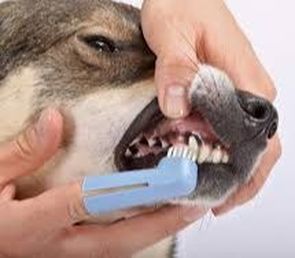
DENTAL CARE FOR DOGS
Why is Dental Health Important?
Dogs and cats can develop dental problems at any age and many over six years of age have some degree of dental disease.
Dental disease can be put into 3 categories:
Tartar
Tartar is the accumulation of plaque on the teeth, usually starting at the gum line in conjunction with gingivitis.
Pyorrhoea
Pyorrhoea is the most serious – it is pus in the mouth, usually between the teeth and the gums. Not only does it cause decay and bad breath but the bacteria may enter the blood and travel to other parts of the body causing more serious problems. The liver, kidney and heart are commonly affected. We treat these conditions because they are actual infections.
Why should I brush my dog's teeth?
Daily removal of plaque is the key to healthy teeth! Unless your dog's teeth are brushed daily, plaque and eventually tartar will build up at the gum line. Infection then occurs, which loosens and destroys the attachment of the tooth.
Brushing your dog's teeth can be an easy and fun procedure (in some pets!). It is easier to start from puppies as they will get used to it very easily. You need a very soft bristled brush (like a child's or baby's toothbrush) and pet toothpaste, which is usually meat flavoured. Do not use human toothpaste as it can be irritating if swallowed and usually pets don't like that minty freshness much.
In dogs that will not allow tooth brushing, the next best thing is a dental diet – this will help control plaque build-up. There are many dental chews available – and these do help, but be aware that on their own they are sometimes not enough to prevent dental disease.
Why does my pet need a scale and polish under anaesthetic?
Once visible tartar has formed on the gum line, this means that there is disease under the gum as well. This needs to be specially removed. It is time for a professional cleaning – do not wait.
Anaesthesia is necessary when performing teeth cleaning – it enables us to clean beneath the gum line, gives pain control, and we place a tube into the windpipe, to ensure that bacteria do not get into the lungs
Why is Dental Health Important?
Dogs and cats can develop dental problems at any age and many over six years of age have some degree of dental disease.
Dental disease can be put into 3 categories:
- Gingivitis
- Gingivitis is inflammation of the gums. You can easily see this by the increase in the pinkness of your dogt's gums, especially at the gum line.
Tartar
Tartar is the accumulation of plaque on the teeth, usually starting at the gum line in conjunction with gingivitis.
Pyorrhoea
Pyorrhoea is the most serious – it is pus in the mouth, usually between the teeth and the gums. Not only does it cause decay and bad breath but the bacteria may enter the blood and travel to other parts of the body causing more serious problems. The liver, kidney and heart are commonly affected. We treat these conditions because they are actual infections.
Why should I brush my dog's teeth?
Daily removal of plaque is the key to healthy teeth! Unless your dog's teeth are brushed daily, plaque and eventually tartar will build up at the gum line. Infection then occurs, which loosens and destroys the attachment of the tooth.
Brushing your dog's teeth can be an easy and fun procedure (in some pets!). It is easier to start from puppies as they will get used to it very easily. You need a very soft bristled brush (like a child's or baby's toothbrush) and pet toothpaste, which is usually meat flavoured. Do not use human toothpaste as it can be irritating if swallowed and usually pets don't like that minty freshness much.
In dogs that will not allow tooth brushing, the next best thing is a dental diet – this will help control plaque build-up. There are many dental chews available – and these do help, but be aware that on their own they are sometimes not enough to prevent dental disease.
Why does my pet need a scale and polish under anaesthetic?
Once visible tartar has formed on the gum line, this means that there is disease under the gum as well. This needs to be specially removed. It is time for a professional cleaning – do not wait.
Anaesthesia is necessary when performing teeth cleaning – it enables us to clean beneath the gum line, gives pain control, and we place a tube into the windpipe, to ensure that bacteria do not get into the lungs

